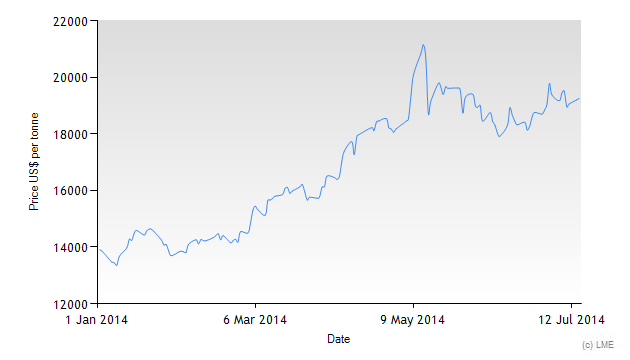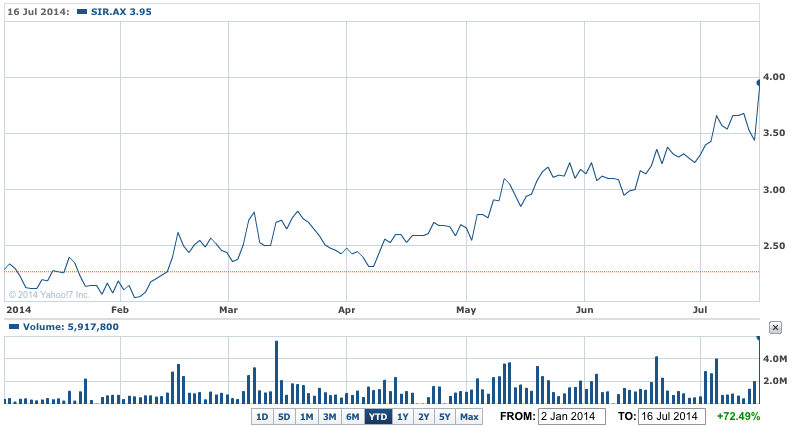Who would have thought that as BHP Billiton (BHP) prepares to sell off its Western Australian nickel operations that a once small exploration company appears to be on the verge of revealing a major new mining province in WA.
Poor returns, too much capital and weak prices saw BHP decide earlier this year to put its Nickel West business on the market – only to find a surge in global nickel prices thanks to a ban on nickel ore and concentrate exports by Indonesia as it tries to force the mining industry to upgrade its exports to finished metal.
The ban (and it applies to tin and has impacted copper as well) has helped nickel prices soar 50% this year so far.
Nickel on the rise

BHP seems to be continuing with the sales process, despite the price rise, but now Perth based Sirius Resources (SIR) seems to be in the early stages of revealing a major new series of nickel, copper (and associated metals, but not gold, so far) to the southeast of many of BHP’s nickel mines around the Kalgoorlie area.
At least one, perhaps two major new mineable discoveries, plus the soaring world price, have helped the Sirius share price jump more than 70% from the start of the year.
Yesterday in fact saw another big leap in the Sirius share price after it revealed a third promising nickel/copper discovery in Western Australia.
The shares jumped almost 15% yesterday to close at $3.95 (they were up around 19% at one stage) after the company said it had made a big new nickel strike near the Fraser Range region of Western Australia, to the southeast of Kalgoorlie and between that historic mining city and the coastal port of Esperance.
The company is now valued at $1.1 billion.
SIR YTD – Sirius on the verge of identifying a major new mining province?

Sirius has already found enough nickel and copper in the Nova and Bollinger deposits to support a highly profitable mine lasting more than 10 years, the drilling results released yesterday suggest the company may have made another major discovery about 80 kilometres away.
Nova would cost more than $473 million to develop and the company says it could generate $10.5 billion of revenue over the 10 years from nickel sales alone (take this with a grain of salt because it’s a projection, but it is promising).
Sirius said the first drill hole into a prospect known as Polar Bear, located in Lake Cowan near the town of Norseman, struck more massive nickel sulphides, not dissimilar to those found at Nova.
The company said in the statement it had discovered massive nickel sulphide mineralisation in the first reconnaissance hole drilled to test the greenfields Taipan prospect at its 100% owned Polar Bear project.
"The high grade massive nickel sulphide mineralisation is accompanied by significant levels of copper, cobalt, platinum and palladium," the company said.
The miner has reported a 4.1 metre section containing 3.8% nickel and 2.45% copper, 0.9g rams per tonne of platinum and 1.6 grams per tonne palladium. As well there was another shorter section with hits of 5.8% nickel, 3.73% copper, 0.12% cobalt, 1.1g/t platinum and 1.65g/t palladium.
"This is an outstanding result given it is the first test of an otherwise unexplored contact," the company said in a statement.
It has to be emphasised that this is only a single drill hole and a better picture will only come from more drilling to delineate the extent of the deposit.
Earlier this week Sirius published a definitive feasibility study for the new mine at Nova, showing it could be one of the lowest-cost nickel mines in the world.
"The Nova deposit is a magmatic nickel sulphide deposit, a style of deposit never before seen in Australia, which occupies a geological structure known as the Eye," Sirius says on its website.
"This style of deposit has many features in common with various aspects of Canadian deposits such as Thompson (owned by Vale), Raglan (owned by Xstrata) and Voisey’s Bay (owned by Vale) which are frequently an order of magnitude larger than most Australian nickel sulphide deposits.
"The presence of copper and cobalt is expected to provide significant by-product credits which is expected to significantly reduce the cost of nickel production.
"In March 2013 Sirius announced a maiden JORC compliant mineral resource estimate at Nova of 10.2 million tonnes of 2.4% Nickel, 1.0% Copper and 0.08% Cobalt for 242,000 tonnes of nickel, 100,000 tonnes of copper and 7,700 tonnes of cobalt based on a 0.6% nickel equivalent cut-off," Sirius said.
The Bollinger deposit was announced in February of last year. It described this as a "a dominantly flat lying body located to the east of the Nova deposit and connected to the Nova deposit by an interpreted feeder zone."
In its announcement earlier in the week, Sirius said the mine is expected to be in production by early 2017, and could be one of the largest (and newest) hard rock mines in recent years.
Sirius yesterday described the region as "the most prospective nickel exploration acreage in Australia".
On its website, Sirius says the Fraser Range project covers an area of over 1,400 square kilometres and "includes over 100 kilometres of strike length of the Proterozoic Albany-Fraser mobile belt on the south-east margin of the Yilgarn Craton."
"In July 2012, Sirius announced the discovery of the Nova nickel-copper-cobalt deposit, which sat within the Fraser Range Joint Venture.
"In May 2014, Sirius completed the purchase of the remaining 30% holding from Mark Creasy and now owns 100% of Nova.
"Sirius has a 70% interest in the Fraser Range Joint Venture, with prospector Mark Creasy retaining a 30% free carried interest to the completion of a bankable feasibility study," the company said.
These announcements are significant because of the obvious care taken to understate the data, and the work done on the Nova project. It wouldn’t surprise if the Nova project is dramatically expanded to cover the new discovery at Polar Bear and a couple of other prospects hinted at in yesterday’s announcement.













